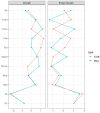How Coparenting Is Linked to Depression among Chinese Young Girls and Boys: Evidence from a Network Analysis
- PMID: 38667093
- PMCID: PMC11047583
- DOI: 10.3390/bs14040297
How Coparenting Is Linked to Depression among Chinese Young Girls and Boys: Evidence from a Network Analysis
Abstract
This study aimed to explore the relationship between parental coparenting and depression among Chinese young adolescents and potential gender differences via network analysis. Thus, 793 fourth-grade students (girls: 281 (35.40%), Mage = 9.99 years, SD = 0.59 years) were recruited from three primary schools in Northern China. The young adolescents rated their depression and perceived paternal and maternal coparenting. Network analysis was used to detect the central nodes and bridge mechanisms among coparenting and depressive components. The results indicated that paternal and maternal consistency as well as maternal conflict were the most central components in the coparenting-depression network. Paternal consistency, maternal conflict and paternal disparagement in coparenting, as well as somatic complaints and positive affect in adolescents' depression, exhibited high bridge strengths, suggesting those constructs served as vital bridges to connect the two subnetworks. Moreover, paternal consistency showed a higher bridge strength in the boys' network than the girls' one, whereas the edge linking adolescents' positive affect to paternal disparagement and integrity was stronger in the girls' network. This study contributes to the understanding of associations between parental coparenting and young adolescents' depression and offered insights into targeted interventions for early adolescent depression by enhancing parental coparenting.
Keywords: coparenting; depression; network analysis; young adolescents.
Conflict of interest statement
The authors declare no conflicts of interest.
Figures




Similar articles
-
Coparenting Behavior, Parent-Adolescent Attachment, and Peer Attachment: An Examination of Gender Differences.J Youth Adolesc. 2020 Jan;49(1):178-191. doi: 10.1007/s10964-019-01068-1. Epub 2019 Jul 15. J Youth Adolesc. 2020. PMID: 31309414
-
A network approach to understanding parenting: Linking coparenting, parenting styles, and parental involvement in rearing adolescents in different age groups.Dev Psychol. 2023 Apr;59(4):786-800. doi: 10.1037/dev0001470. Epub 2022 Sep 29. Dev Psychol. 2023. PMID: 36174179
-
Bidirectional influences between dimensions of coparenting and adolescent adjustment.J Youth Adolesc. 2014 Feb;43(2):257-69. doi: 10.1007/s10964-013-9940-6. Epub 2013 Mar 29. J Youth Adolesc. 2014. PMID: 23539238 Free PMC article.
-
Systematic review of the impact of coparenting interventions on paternal coparenting behaviour.J Adv Nurs. 2019 Jan;75(1):17-29. doi: 10.1111/jan.13815. Epub 2018 Sep 25. J Adv Nurs. 2019. PMID: 30066488
-
How parental depression influences the development of adolescent depression: based on data from China family panel studies.Front Psychol. 2025 Apr 30;16:1514024. doi: 10.3389/fpsyg.2025.1514024. eCollection 2025. Front Psychol. 2025. PMID: 40370400 Free PMC article. Review.
References
-
- Wiebenga J.X.M., Dickhoff J., Mérelle S.Y.M., Eikelenboom M., Heering H.D., Gilissen R., van Oppen P., Penninx B.W.J.H. Prevalence, Course, and Determinants of Suicide Ideation and Attempts in Patients with a Depressive and/or Anxiety Disorder: A Review of NESDA Findings. J. Affect. Disord. 2021;283:267–277. doi: 10.1016/j.jad.2021.01.053. - DOI - PubMed
-
- Hankin B.L., Young J.F., Abela J.R.Z., Smolen A., Jenness J.L., Gulley L.D., Technow J.R., Gottlieb A.B., Cohen J.R., Oppenheimer C.W. Depression from Childhood into Late Adolescence: Influence of Gender, Development, Genetic Susceptibility, and Peer Stress. J. Abnorm. Psychol. 2015;124:803–816. doi: 10.1037/abn0000089. - DOI - PMC - PubMed
Grants and funding
LinkOut - more resources
Full Text Sources

